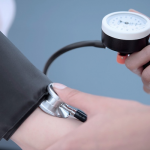When discussing taming the silent killer it is important to understand the role smoking has in raising your blood pressure.
The simple explanation is that nicotine acts as a vasoconstrictor and stimulant. Vasoconstriction results in narrowing of the arteries, which causes a rise in your blood pressure. Nicotine also increases your heart rate which can increase your blood pressure as well.
Family history, obesity, sedentarylifestyle, alcohol, poor nutrition all play a role in high blood pressure; however, smoking cessation is one thing you can do right now and quickly start seeing the benefits on blood pressure reduction.
http://www.amazon.com/gp/product/B004D9P1A8/ref=as_li_qf_sp_asin_il_tl?ie=UTF8&camp=1789&creative=9325&creativeASIN=B004D9P1A8&linkCode=as2&tag=musclbuildexc-20
Smoking also has more long term affects on blood pressure by contributing to hardening of the arteries. Over time plaque develops in the walls of your arteries making the blood vessel stiffer. This decrease in flexibility of the artery wall causes the blood pressure to rise.
The long term effects of smoking and nicotine can lead to increased risk of strokes, heart attacks, kidney problems, peripheral vascular disease, loss of vision and even death.
This does not even take into account the risk of developing lung cancer and chronic lung disease from years of smoking.
It is estimated that if you quit smoking your risk of heart attack will decrease after one year of not smoking. This means that smoking is such a potent health hazard that it takes one year for the chemical substances to clear your body to decrease your risk of heart attack.
Smoking adds carbon monoxide to your blood and carbon monoxide competes with your hemoglobin in binding to oxygen. This causes the heart to work harder to supply oxygenated blood throughout the body.
Smoking also increases your blood cholesterol and fibrinogen. Fibrinogen is a factor that affects clotting of the blood. The affect on both of these factors means that a smoker’s blood will clot more easily and increase the risk of heart attack and stroke. This increases the risk of coronary heart disease, peripheral vascular disease, stroke and heart attack.
The cilia, or small hairs that keep the lungs clean, are unable to sweep away the harmful chemicals that assault the lungs each day with smoking. Eventually this damage can contribute to the development of cancer and chronic lung disease. This damage affects the ability of the lungs to oxygenate blood resulting in the development of pulmonary hypertension.
The ability to tame the silent killer is adversely affected by smoking. These affects are short term and long term.
If you are a smoker and dealing with high blood pressure, smoking cessation may be the best intervention you can do to achieve blood pressure control and more optimal health.



